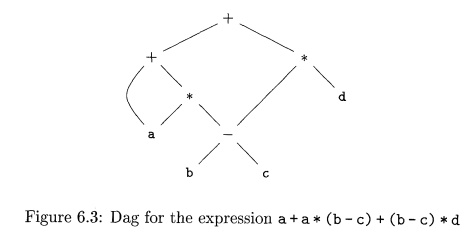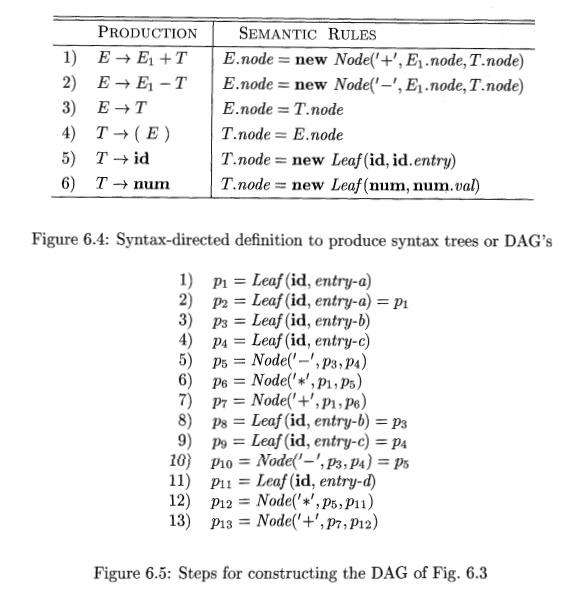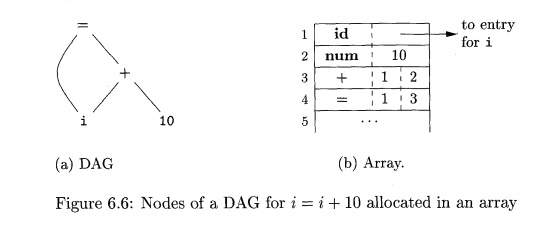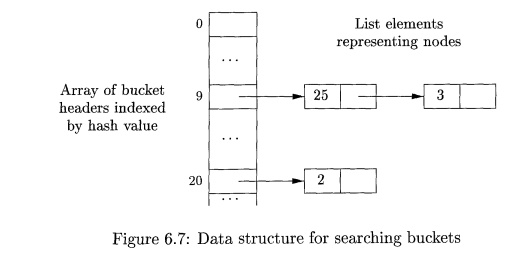Chapter: Compilers : Principles, Techniques, & Tools : Intermediate-Code Generation
Variants of Syntax Trees
Variants of Syntax Trees
1 Directed Acyclic Graphs for
Expressions
2 The Value-Number Method for
Constructing DAG's
3 Exercises for Section 6.1
Nodes in a syntax tree represent constructs in the source program; the
children of a node represent the meaningful components of a construct. A
directed acyclic graph (hereafter called a DAG)
for an expression identifies the common
subexpressions (subexpressions that
occur more than once) of the expression. As
we shall see in this section, DAG's can be constructed by using the same
techniques that construct syntax trees.
1. Directed Acyclic Graphs for
Expressions
Like the syntax tree for an expression, a DAG has
leaves corresponding to atomic operands and interior codes corresponding to
operators. The difference is that a node N
in a DAG has more than one parent if N
represents a com-mon subexpression; in a syntax tree, the tree for the common
subexpression would be replicated as many times as the subexpression appears in
the original expression. Thus, a DAG not only represents expressions more
succinctly, it gives the compiler important clues regarding the generation of
efficient code to evaluate the expressions.
Example 6.1:
Figure 6.3 shows the DAG for the expression
a + a * (b - c) + (b - c) * d
The leaf for a has two parents, because a appears twice in the
expression. More interestingly, the two occurrences of the common subexpression
b - c are represented by one node, the node labeled —. That node has two
parents, representing its two uses in the subexpressions a* (b - c) and (b -
c)*d . Even though b and c appear twice in the complete expression, their nodes
each have one parent, since both uses are in the common subexpression b - c . •

The SDD of Fig. 6.4 can construct either syntax trees or DAG's. It was
used to construct syntax trees in Example 5.11, where functions Leaf and Node
created a fresh node each time they were called. It will construct a DAG if,
before creating a new node, these functions first check whether an identical
node already exists. If a previously created identical node exists, the
existing node is returned. For instance, before constructing a new node,
Node(op, left, right) we check whether there is already a node with label op,
and children left and right, in that order. If so, Node returns the existing
node; otherwise, it creates a new node.
Example 6.2 : The sequence of steps shown in Fig. 6.5 constructs the DAG
in Fig. 6.3, provided Node and Leaf return an existing node, if possible, as
discussed abve. We assume that entry-a points to the symbol-table entry for a,
and similarly for the other identifiers.

When the call to Leaf (id, entry-a) is repeated at step 2, the node
created by the previous call is returned, so p2 = Pi • Similarly, the nodes
returned at steps 8 and 9 are the same as those returned at steps 3 and 4
(i.e., ps = p3 and PQ = p^). Hence the node returned at step 10 must be the
same at that returned at step 5; i.e., pio = P5- •
2. The Value-Number Method for
Constructing DAG's
Often, the nodes of a syntax tree or DAG are stored in an array of
records, as suggested by Fig. 6.6. Each row of the array represents one record,
and therefore one node. In each record, the first field is an operation code,
indicating the label of the node. In Fig. 6.6(b), leaves have one additional
field, which holds the lexical value (either a symbol-table pointer or a
constant, in this case), and interior nodes have two additional fields
indicating the left and right children.

In this array, we refer to nodes by giving the integer index of the
record for that node within the array. This integer historically has been called
the value number for the node or for the expression represented by the node.
For instance, in Fig. 6.6, the node labeled -I- has value number 3, and its
left and right children have value numbers 1 and 2, respectively. In practice,
we could use pointers to records or references to objects instead of integer
indexes, but we shall still refer to the reference to a node as its "value
number." If stored in an appropriate data structure, value numbers help us
construct expression DAG's efficiently; the next algorithm shows how.
Suppose that nodes are stored in an array, as in Fig. 6.6, and each node
is referred to by its value number. Let the signature of an interior node be
the triple (op,/,r), where op is the label, I its left child's value number,
and r its right child's value number. A unary operator may be assumed to have r
= 0-
Algorithm 6.3 The value-number method for constructing the nodes of a
DAG.
INPUT : Label op, node /, and node r.
OUTPUT : The value number of a node in the array with signature (op,
l,r).
METHOD : Search the array for a node M with label op, left child I, and
right child r. If there is such a node, return the value number of M. If not,
create in the array a new node N with label op, left child I, and right child
r, and return its value number.
While Algorithm 6.3 yields the desired output, searching the entire array every time we are asked to locate one node is expensive, especially if the array holds expressions from an entire program. A more efficient approach is to use a hash table, in which the nodes are put into "buckets," each of which typically will have only a few nodes. The hash table is one of several data structures that support dictionaries efficiently.1 A dictionary is an abstract data type that allows us to insert and delete elements of a set, and to determine whether a given element is currently in the set. A good data structure for dictionaries, such as a hash table, performs each of these operations in time that is constant or close to constant, independent of the size of the set.
To construct a hash table for the nodes of a DAG, we need a hash function
h that computes the index of the bucket for a signature (op, I, r), in a way
that distributes the signatures across buckets, so that it is unlikely that any
one bucket will get much more than a fair share of the nodes. The bucket index
h(op, I, r) is computed deterministically from op, I, and r, so that we may
repeat the calculation and always get to the same bucket index for node (op, I,
r).
The buckets can be implemented as linked lists, as in Fig. 6.7. An
array, indexed by hash value, holds the bucket headers, each of which points to
the first cell of a list. Within the linked list for a bucket, each cell holds
the value number of one of the nodes that hash to that bucket. That is, node
(op,l,r) can be found on the list whose header is at index h(op,l,r) of the array.

Thus, given the input node op, I, and r, we compute the bucket index
h(op,l,r) and search the list of cells in this bucket for the given input node.
Typically, there are enough buckets so that no list has more than a few cells.
We may need to look at all the cells within a bucket, however, and for each
value number v found in a cell, we must check whether the signature (op,l,r) of
the input node matches the node with value number v in the list of cells (as in
Fig. 6.7) . If we find a match, we return v. If we find no match, we know no
such node can exist in any other bucket, so we create a new cell, add it to the
list of cells for bucket index h(op, l,r), and return the value number in that
new cell.
3. Exercises
for Section 6.1
Exerc ise 6. 1 . 1 : Construct
the DAG for the expression
((a; + y)- {{x + y)*(x- y)))
+ ((x + y) * (x
- y))
Exercise 6 . 1 . 2 : Construct the DAG and identify the value numbers
for the subexpressions of the following expressions, assuming + associates from
the left.
a + b+ (a + b).
a + b + a + b.
a + a + ((fl + a + a + (a + a + a + a)) .
Related Topics